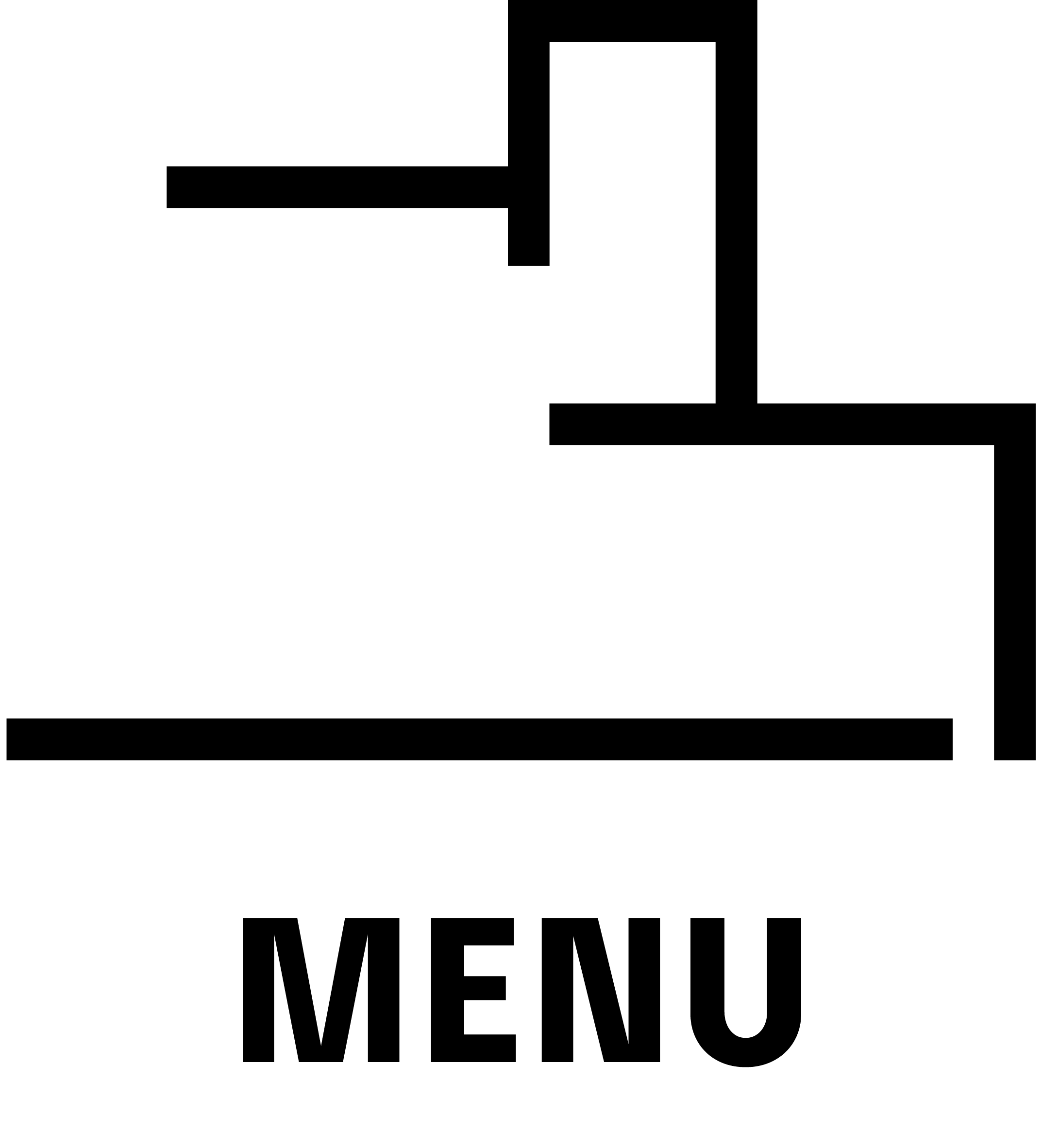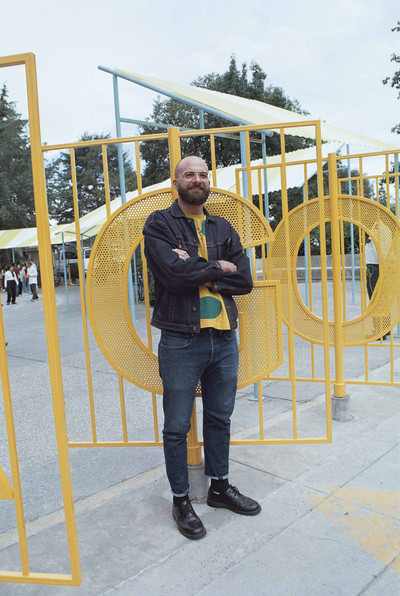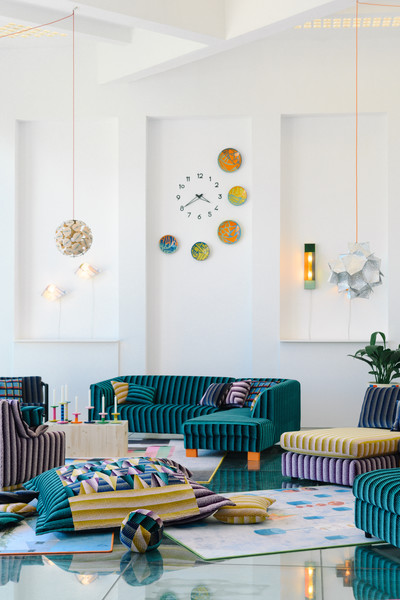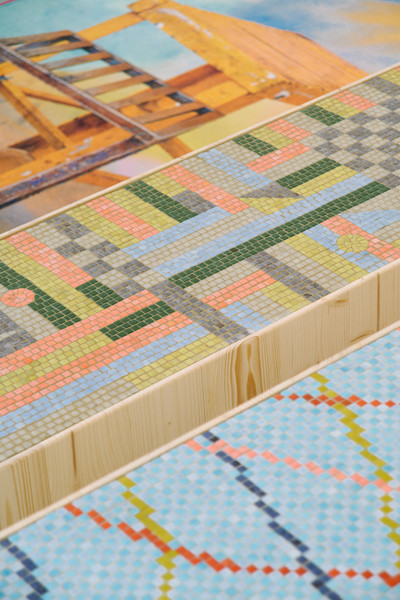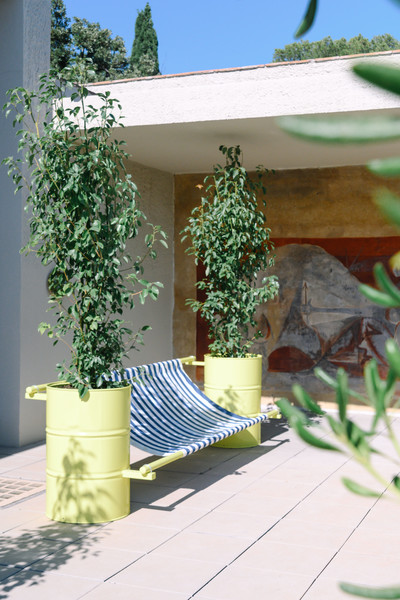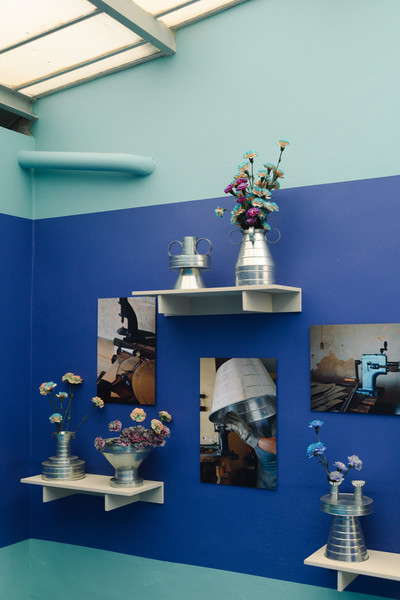Fabien Cappello, On se rejoint à la villa !
On a bright July morning last year in his adopted city of Guadalajara, Mexico, Fabien Cappello opened a local newspaper called Mural and stumbled on a news item about, as luck would have it, a mural. Cappello didn’t think much of the image, a towering eighteenth-century bishop blessing the city’s monuments, but the craftsmanship of the delicate mosaic was unmistakable. The workshop that had produced it, called Taller de Mosáico Artístico, happened to occupy a tiny slip of a space a short distance from Cappello’s own studio. Before long, they’d begun to collaborate on a sequence of gem-coloured surface designs, equal parts Byzantium and Burle Marx: undulant fields of circles and waves; geometric fantasias; a loose weave of salmon, coral, ochre and navy unfurled over a field of robin’s-egg blue, like a fishnet gone slack in the water.
This last design Cappello first conceived as a textile. The workers at Taller de Mosáico Artístico translated it into a hardscape that might, at some point, become a textile again, conserving the archaic pixellation introduced by the ceramic tiles. Here in France, at villa Noailles, Cappello and his team have embedded those mosaics (flat-packed and shipped from Guadalajara) in simple pine frames to make them tables. Lent sudden but definite utility, it’s as if the mosaics had been caught by surprise, as if one possibility among many had been captured in cinematic freezeframe at a moment of becoming – which might be as good a definition as any for Cappello’s approach to design.
Since founding his practice in London in 2010, and especially since relocating it to Mexico in 2016, Cappello has used design to understand the systems of production and exchange that thrive in the interstices between industry and craft. Rather than working with traditional weavers or ceramicists – totemic figures in the mythic construction of Mexico’s material identity – Cappello seeks out the cottage industries that form the basis of countless urban micro-economies, as well as unexpected applications for materials so quotidian that most people don’t include them in conversations about “design” at all.
That might mean collaborating with a family tinplate workshop in Guadalajara to make vases and lampshades using the same rudimentary tools they typically apply to ordinary household items like cake moulds, measuring cups and watering cans. It might just as easily mean dreaming up acid-bright surface designs to print on hard-wearing polyester velvet, produced in the industrial city of Lerma by a company that specializes in, among other things, upholstery for passenger buses. Here you’ll see them on couches and armchairs, but they might work just as well in airports or hospital waiting rooms. Cappello’s objects are expressive of the situations that create them, but they are also the situations they create.
Some examples: the benches on the terrace, with their oil-can planters and striped waterproof-canvas seats, marry the proportions and forms of the iconic sling chairs designed by villa Noailles’s architect, Robert Mallet-Stevens, with the basic structure of Cappello’s Guadalajara garden benches. He’s used these replicable prototypes to make parklets out of parking spots, each one a micro-occupation that turns private space public. (Perhaps they’ll have a second life here in Hyères?) Each design in the squall of wallpapers swirling around the squash court leapt off some other surface – fibreglass or ceramic or fabric – as if restless to see what it might feel like to live in another dimension, to look down from a wall instead of up from a seat or a flowerpot. The furnishings scattered freely over the villa’s swimming pool are all second-hand, many of them donated or lent by the villa’s staff, covered over with Cappello’s fabrics. What happens to them when the show ends is anybody’s guess.
The things you’ll see and interact with today are not points or periods at the end of a finely tuned sentence. They’re question marks and semicolons, asking what we imagine for them next, connecting ideas and spaces that might otherwise seem separate: many of them combine elements fabricated 10,000 kilometres away with components assembled right where you’re standing. These are not collectables; this is not a show. It’s a collective living room and a salon, a place to sit and talk and think. The objects are the catalysts. Put yourself in a situation and see where it leads.
Fabien, thank you for sharing this space vite us.
Why Guadalajara?
Guadalajara has been part of my life since 2016 when I gave classes on industrial design there for a semester. In some sense, it’s where I got to know Mexico. First, I’d say it’s a place that allows you to focus: it’s still a big city, but it moves at a slower pace. Another part is formal and spatial: the richness of the modern movement here, the way people use public space, these beautiful urban landscapes filled with youth. There are so many moments in this city that I love, but maybe the most important ones come from the fact that this is still a city and region of production, and I don’t think there are many cities in the world that still have that. It’s a city that maintains pre-Hispanic techniques of stone-carving and earthenware alongside major industries, and between those two poles, there are endless workshops. On every corner, you’ll find a metalworker or a carpenter, and that’s been invaluable for me and my work, and for the amazing scene of creatives that lives here.
How does your design practice influence or participate in the economies and localities that surround it?
To answer that question, it’s important to talk about the specific people and places that surround my studio. In some ways, industrial design has historically been very disconnected from people, and that’s a paradigm I want to change. Objects interest me less than their potential to generate moments, and that includes the moments, places and, above all, people who fabricate them. I’m also always interested in public space, or at least shared space, so it’s about what you can make here and now, using tools and materials that already exist. My work is not abstract or conceptual: it focuses on the quotidian and the mundane. In the world of design, there’s so much that’s speculative or that exists outside of the reality that creates it and that it creates.
For me, the idea of the “local” is more a methodology than an ideology – this isn’t a manifesto, it’s a daily practice – and the work with Hojalata is a great example of what I mean by that and how I try to work. Every project begins with a phase of research and observation. For hojalata, we started by mapping workshops, and in that process, we realised that Guadalajara is actually a very important centre for production. From there, we were able to catalogue and analyse the various tools made by these workshops and their diversity of uses. A lot of people talk about “inspiration,” about being “inspired” by this designer or that style, but that’s not an idea that’s ever really spoken to me. What I’m trying to do is remind people that these techniques exist and demonstrate that they work, that they’re valuable as they are, even if they’re usually overlooked.
Here, again, is the idea of working with what already exists in order to talk about contemporary forms and uses, and this methodology inherently takes you beyond the goal of just producing objects. I only start to draw, for instance, when I know what tools in what workshop will be used and (most of the time) who is going to make the final object. That was true for the hojalata pieces and it’s true throughout my work. I don’t conceptualize an object until I understand exactly what resources are available to me. For me, the job of the designer is to define and establish a methodology; the object is what comes out of that tool when it’s applied to a specific context. I never come into the studio saying, “Today, I’m going to draw an object.” I come in and say, “Today, I’m going to understand something a little bit better.”
How does this exhibition connect to villa Noailles – both the context of the building itself and its history, present and future?
As I planned this project, it was really important to me not to send a show to the villa. As a studio, we had to figure out what we would make here in Guadalajara and what we would make in France, working together with the resources and team of villa Noailles but also a selection of their partners. I wanted to be the most specific possible, and that meant understanding the logistics of what was possible. My team and I wanted that contrast, that journey, to be legible inside the space we would create. The show would clearly be made with an understanding the resources we had. Whenever we could, instead of sending completed objects, we sent materials I designed, like mosaic surfaces and fabrics. I also wanted to make sure that at no point in the show would there be “exhibition design,” as such. I wanted to think of this whole project as creating a public space within a cultural institution, using the resources of institution itself.
In the space of the pool, we designed a real, usable living room using only furniture. It’s not speculative in any way. These objects are really living together, they have a common use, they exist in relation to one another. And the public is invited to use that space, too, not just walk through it. We wanted to play with recreating the way the space would have been lived in originally, which you can see very clearly in the archival images. This was a place for health and sport and relaxation, yes, but it was also for visits and gatherings, for these salons where there must have been endless fascinating conversations. I wanted to recreate those salons – except this time, everyone is invited.
In the squash court, we created what I think of as a sort of “design archive” of surface designs that we’ve used in various projects in the last five years. The patterns have been blown up in scale and applied to the walls. It’s a functional space, too – there are seats, which are an extension of the surface design that covers the floor – but I also wanted it to feel open and suggestive of different potential uses. It’s a place to rest and make the most of the cool air in the only space that has air conditioning during your visit. I like that it’s for resting but has a lot of visual intensity. I believe our eyes can take on a lot more information than we think. You can learn a lot from this kind of constant stimulation; colours and patterns aren’t distractions. When I talk about visual “intensity,” I’m thinking specifically about urban spaces in Mexico and everything we can learn to read within them, the way that different colours and patterns transmit information. And that’s functional – it’s functional to use colour or surface designs to define an object or give it an identity. You describe a space as a “yellow room,” but that colour is just the thinnest layer over the solid material of the walls and still it defines the space.
Colours radiate. So maybe that’s true of uses, as well? Maybe when seating emerges from the floor, as part of the floor and part of the surface of the floor – maybe then the whole room becomes a bench in the same way it might become yellow or green or red. Again, the surface coverings are just paper, they’re infinitely changeable, and yet they define the entire space. Furniture, too, can adapt to different spaces, and propose different uses for them.
How does the selection of designers who participated in the competition express these larger ideas? What were you and the jury looking for in your selection of projects to present?
In 2005, when I was twenty-one, I was one of ten young designers selected to participate in the first edition of Design Parade, so I’m familiar with the process and the experience of participating in a competition. I proposed to the members of the jury that we understand these proposals as things we could learn from, and from there, try to determine which practices we were most excited to see extend into the future. It was important that we weren’t just judging the proposals, but that we were really paying attention to what these 300 young designers were proposing collectively. What they’re suggesting are ultimately ideas for what the future of design can be; our job was to identify the common values and interests that emerged from all these proposals taken together. For example, many of them were using their projects to talk about redefining the role of the designer. Others were thinking about how to apply design to new understandings and modes of production, and not necessarily in a technological sense. And we were thrilled to see designers that focused so much on the end user, rather than on the object as an artefact.
Once we’d identified those categories, we tried to select the designer within each whose solutions were sharpest, whose engagement with the idea and its consequences was clearest, and who materialized those themes most effectively. I think we’ve chosen designers who, together, can define that future landscape. The most valuable thing we can do here is to bring these unconventional solutions to light.
